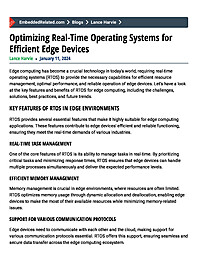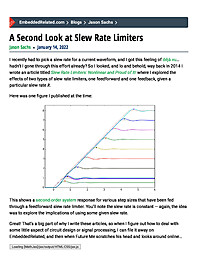
A Second Look at Slew Rate Limiters
I recently had to pick a slew rate for a current waveform, and I got this feeling of déjà vu… hadn’t I gone through this effort already? So I looked, and lo and behold, way back in 2014 I wrote an article titled Slew Rate...

Supply Chain Games: What Have We Learned From the Great Semiconductor Shortage of 2021? (Part 1)
So by now I’m sure you’ve heard about the semiconductor shortage of 2021. For a few complicated reasons, demand is greater than supply, and not everybody who wants to buy integrated circuits can do so. Today we’re going to try...
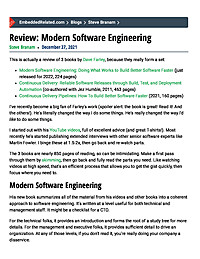
Review: Modern Software Engineering
This is actually a review of 3 books by Dave Farley, because they really form a set: Modern Software Engineering: Doing What Works to Build Better Software Faster (just released for 2022, 224 pages) Continuous Delivery: Reliable...
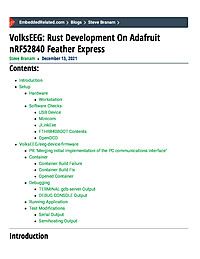
VolksEEG: Rust Development On Adafruit nRF52840 Feather Express
Contents: Introduction Setup Hardware Workstation Software Checks USB Device Minicom JLinkExe FTHR840BOOT Contents OpenOCD VolksEEG/eeg-device-firmware PR "Merging initial implementation of the PC communications...
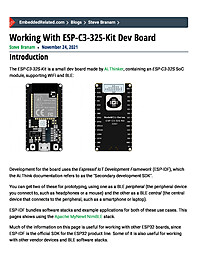
Working With ESP-C3-32S-Kit Dev Board
Introduction The ESP-C3-32S-Kit is a small dev board made by Ai.Thinker, containing an ESP-C3-32S SoC module, supporting WiFi and BLE: Development for the board uses the Espressif IoT Development Framework...
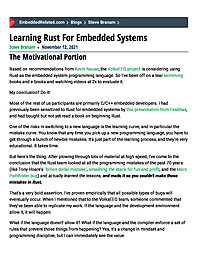
Learning Rust For Embedded Systems
The Motivational PortionBased on recommendations from Kevin Nause, the VolksEEG project is considering using Rust as the embedded system programming language. So I've been off on a tear skimming books and e-books and watching videos at 2x to...
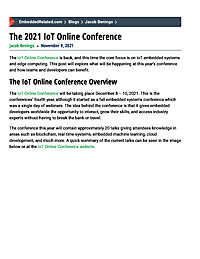
The 2021 IoT Online Conference
The IoT Online Conference is back, and this time the core focus is on IoT embedded systems and edge computing. This post will explore what will be happening at this year’s conference and how teams and developers can benefit. The...
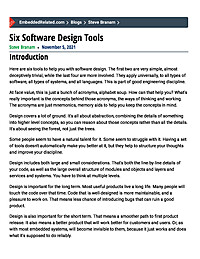
Six Software Design Tools
Introduction Here are six tools to help you with software design. The first two are very simple, almost deceptively trivial, while the last four are more involved. They apply universally, to all types of software, all types of systems, and...
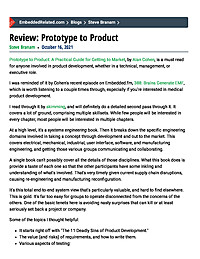
Review: Prototype to Product
Prototype to Product: A Practical Guide for Getting to Market, by Alan Cohen, is a must-read for anyone involved in product development, whether in a technical, management, or executive role. I was reminded of it by Cohen's recent...
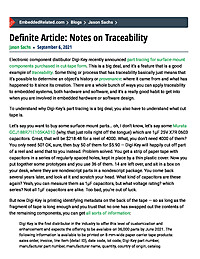
Definite Article: Notes on Traceability
Electronic component distibutor Digi-Key recently announced part tracing for surface-mount components purchased in cut-tape form. This is a big deal, and it’s a feature that is a good example of traceability. Some thing or process that has...
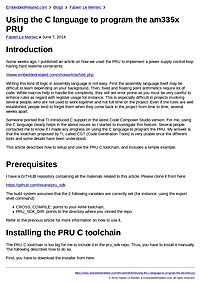
Using the C language to program the am335x PRU
Introduction Some weeks ago, I published an article on how we used the PRU to implement a power supply control loop having hard realtime constraints: http://www.embeddedrelated.com/showarticle/586.php Writing this kind of logic in assembly...
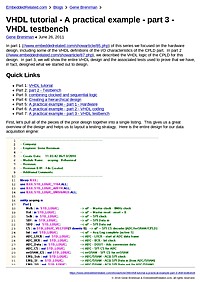
VHDL tutorial - A practical example - part 3 - VHDL testbench
In part 1 (http://www.embeddedrelated.com/showarticle/85.php) of this series we focused on the hardware design, including some of the VHDL definitions of the I/O characteristics of the CPLD part. In part 2...

Adventures in Signal Processing with Python
Author’s note: This article was originally called Adventures in Signal Processing with Python (MATLAB? We don’t need no stinkin' MATLAB!) — the allusion to The Treasure of the Sierra Madre has been removed, in deference to being...
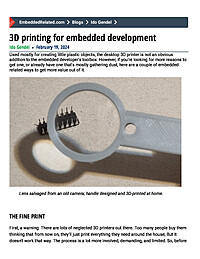
3D printing for embedded development
Used mostly for creating little plastic objects, the desktop 3D printer is not an obvious addition to the embedded developer's toolbox. However, if you're looking for more reasons to get one, or already have one that's mostly gathering dust, here are a couple of embedded-related ways to get more value out of it.
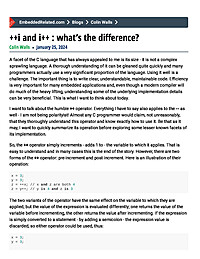
++i and i++ : what’s the difference?
Although the ++ and -- operators are well known, there are facets of their operation and implementation that are less familiar to many developers.
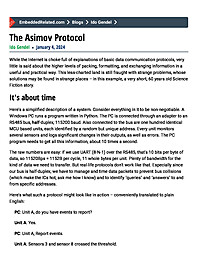
The Asimov Protocol
While the Internet is choke-full of explanations of basic data communication protocols, very little is said about the higher levels of packing, formatting, and exchanging information in a useful and practical way. This less-charted land is still fraught with strange problems, whose solutions may be found in strange places – in this example, a very short, 60 years old Science Fiction story.
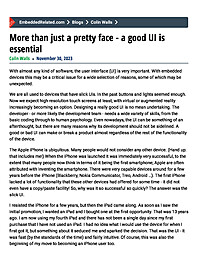
More than just a pretty face - a good UI is essential
A user interface can make or break a device - determining its success in the marketplace. With careful design, the UI can make the product compelling and result in a high level of satisfaction from new and experienced users.






